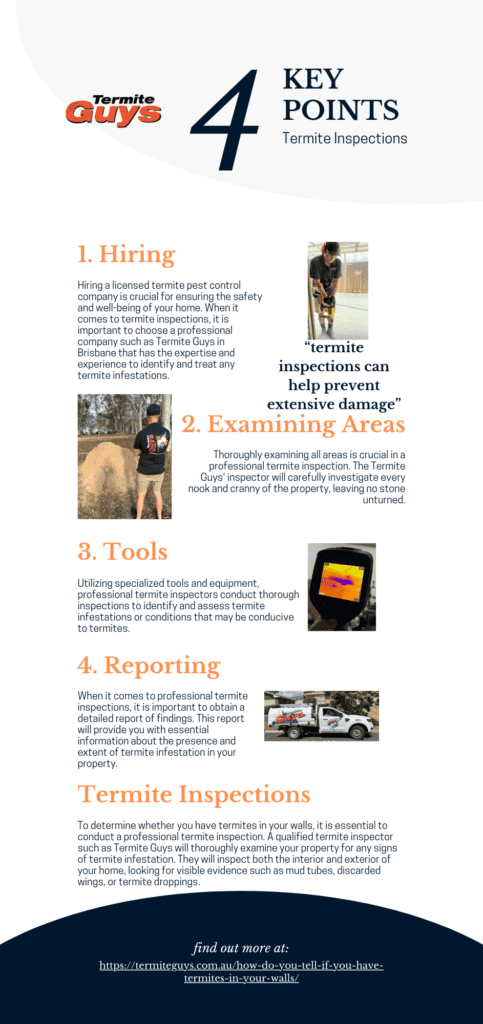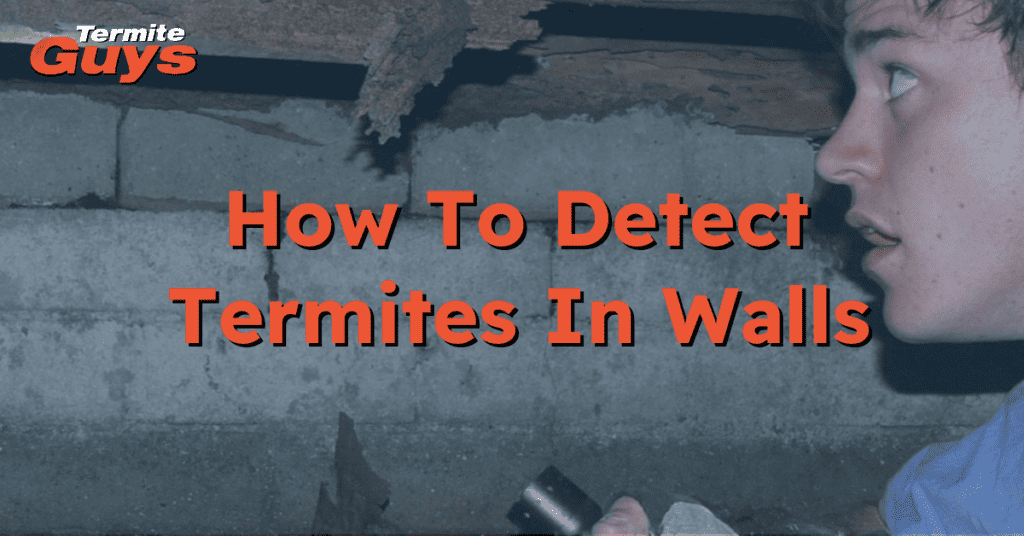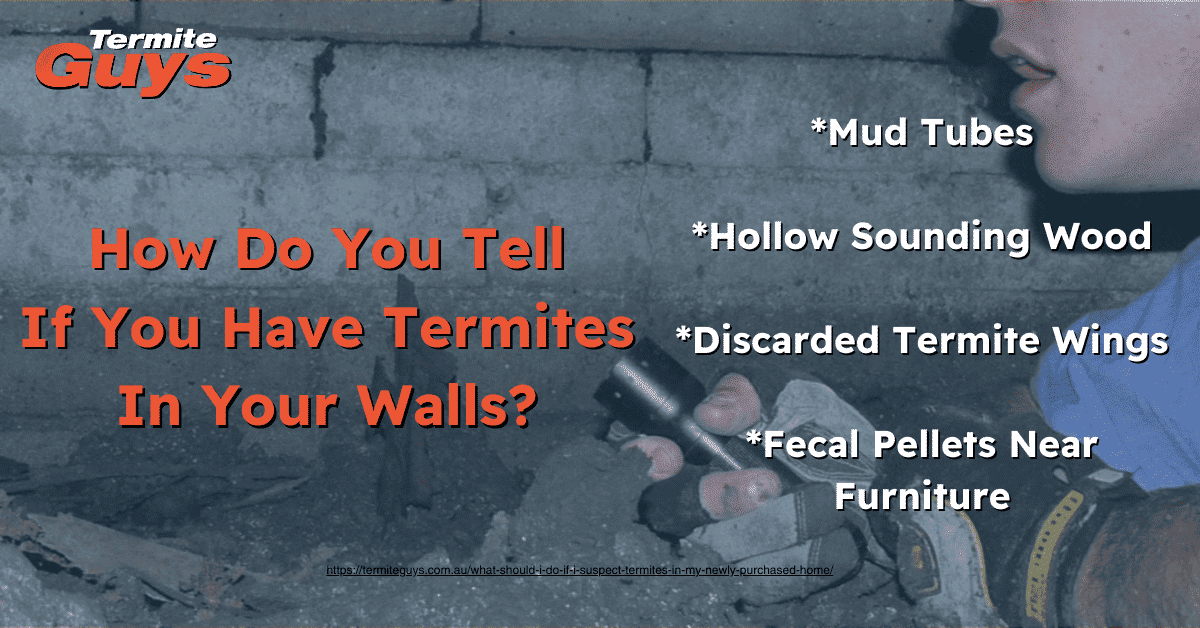Termites are sneaky creatures, silently wreaking havoc on your home without you even knowing it. One way to tell if you have termites in your walls is by inspecting for the presence of mud tubes. These tunnels, usually about the width of a pencil, serve as highways for termites to travel between their nest and their food source. If you notice small, granular pellets near your walls, it could be a clear indication of termite activity. Additionally, if you tap on your walls and hear a hollow sound, this could also be a red flag.
Termites eat away at the wood, causing it to become hollow and weak. Cracked or bubbling paint on your walls could be another sign of termites. These pests release moisture as they eat through the wood, which can make the paint bubble or crack. Furthermore, if you notice discarded termite wings around your home, this could be a sign that a termite colony has established itself nearby.
Termites shed their wings after swarming, so finding these discarded wings can suggest that an infestation is occurring. Lastly, if you see any visible damage to your walls or notice that they feel soft or spongy, it’s time to call a professional. Termites can cause extensive structural damage to your home, so it’s important to address the issue as soon as possible.
Ways you can identify if you have termites:
1. Signs Of Termite Infestation
There are several signs that may indicate a termite infestation in your walls. One common sign is the presence of mud tubes, which termites use to travel from their colonies to a food source. These tubes are typically found on the exterior walls of your home and can vary in size. Another sign is the presence of discarded wings, as termites swarm and shed their wings when they find a suitable location to start a new colony. Additionally, if you notice any hollow-sounding wood or wood that is easily damaged, it could be a sign of termite activity. It’s important to address these signs promptly to prevent further damage to your home.
Termites are known to be silent destroyers, but there are a few indicators that can help you determine if they have made their way into your walls. Look out for small, pinpoint holes on walls or ceilings, as these could be entry points for termites. Another sign is the presence of bubbling or peeling paint, as termites can cause moisture build-up and damage to the paint on your walls. It is important to regularly inspect your walls for these signs and contact a professional if you suspect a termite infestation.
A. Mud Tubes On Walls
One common indicator is the presence of mud tubes along the foundation or on walls of your home. These tubes are built by termites to provide protection and moisture as they travel between their nest and a food source. Finding mud tubes around the exterior of your home is a strong indication that termites are active and nesting nearby. Other signs include hollow-sounding wood, buckling or sagging floors, and small holes in drywall or wallpaper. If you suspect termite activity in your home, it is important to act quickly to minimize the potential damage. A professional inspection can confirm the presence of termites and determine the most appropriate course of treatment.
If you notice these tubes on your walls, foundations or exterior of your home, it is important to take immediate action as termites can cause significant damage to the structure of your home. Call a professional termite pest control company to assess the situation and implement appropriate treatment measures.
B. Hollow-sounding Wood
Does the wood in your home sound hollow when you tap on it? If so, this could be a sign of a termite infestation lurking within the walls. Termites have a voracious appetite for wood and will tunnel through it, causing it to become hollow and weakened. This can make the wood sound hollow when tapped on, indicating that termites may be present.
C. Discarded Termite Wings
Discarded termite wings are another common sign of termite infestation. These wings are often found near windowsills, door frames, or other areas where termites may enter the home. The presence of discarded wings indicates that a termite colony is nearby, as termites shed their wings after swarming to mate and establish new colonies. If you notice these wings in your home, it is important to take immediate action to prevent further damage. Contacting a professional pest control company is the best course of action to safely and effectively eliminate the termite infestation and prevent future damage to your property.
D. Fecal Pellets Near Furniture
Signs of a potential termite infestation can include the presence of fecal pellets near furniture. These small droppings are often mistaken for sawdust or dirt, but upon closer inspection, they reveal small, elongated shapes that resemble tiny capsules. If you notice these fecal pellets around your furniture, it could be a clear indication that termites are present and actively feeding on the wood. This is a serious matter that requires immediate attention from a professional exterminator to prevent further damage to your property.
Mud tubes or tracks may also be seen where fecal matter is present on or near timber furniture. These tunnels, can be made from a combination of soil, timber debris and termite saliva, they serve as protected highways for termites to travel between their nest and their food source. If you notice any mud tubes, it is important not to disturb them as they are crucial in identifying the location of the termite colony. Contacting a termite pest control specialist who has experience in termite extermination is essential in effectively eradicating these destructive pests from your home or business.
2. Professional Termite Inspection
To determine whether you have termites in your walls, it is essential to conduct a professional termite inspection. A qualified termite inspector such as Termite Guys will thoroughly examine your property for any signs of termite infestation. They will inspect both the interior and exterior of your home, looking for visible evidence such as mud tubes, discarded wings, or termite droppings.
Additionally, they may use specialized tools like moisture meters and thermal imaging cameras or infrared cameras to detect any hidden termite activity within your walls. With their expertise and knowledge, a professional termite inspector can accurately assess the presence of termites and recommend appropriate treatment options. Furthermore, scheduling regular termite inspections can help prevent extensive damage and provide peace of mind for homeowners.

A. Hiring A Licensed Termite Pest Control Company
Hiring a licensed termite pest control company is crucial for ensuring the safety and well-being of your home. When it comes to termite inspections, it is important to choose a professional company such as Termite Guys in Brisbane that has the expertise and experience to identify and treat any termite infestations. A licensed company will be able to provide effective and safe treatment options to eliminate the termites and prevent future infestations.
When hiring a licensed termite pest control company, it is essential to consider their reputation and track record in the industry. Look for companies that have a proven history of successfully resolving termite issues and protecting homes from further damage. Check for reviews and testimonials from previous customers on Google to gauge the quality of their services. Additionally, inquire about their certifications and licenses to ensure that they meet the necessary requirements to perform termite inspections and treatments. Remember, hiring a licensed company will give you peace of mind knowing that trained professionals are handling your termite problem.
B. Thoroughly Examining All Areas
Thoroughly examining all areas is crucial in a professional termite inspection. The Termite Guys’ inspector will carefully investigate every nook and cranny of the property, leaving no stone unturned. From the foundation to the roof void, they will diligently search for any signs of termite activity or damage.
During the inspection, the professional will utilize specialized tools and equipment to aid in their examination. They may use moisture meters to detect any excessive moisture levels, as termites are attracted to damp environments. They will also look for mud tubes, which are tunnels that termites create to travel between their nests and food sources. By thoroughly examining all areas of the property, the inspector can accurately assess the presence and extent of any termite infestation.
C. Utilizing Specialized Tools And Equipment
Utilizing specialized tools and equipment, professional termite inspectors conduct thorough inspections to identify and assess termite infestations or conditions that may be conducive to termites. Armed with moisture meters, thermal imaging cameras, and borescopes, these experts search for signs of termite activity, such as mud tubes, termite wings, and damaged wood. By employing these advanced technologies, inspectors can detect both visible and hidden termite colonies, allowing homeowners to take prompt, effective action to prevent further damage.
In addition to their specialized tools, professional termite inspectors also rely on their expertise and knowledge of termite behavior. Through extensive training and experience, they can identify different termite species and assess the extent of the infestation. By understanding the biology and habits of termites, inspectors can make accurate recommendations for treatment options and provide homeowners with valuable insights on how to prevent future termite problems. As the first line of defence against termite damage, professional termite inspections serve as an essential step in ensuring the structural integrity of homes and buildings.
D. Obtaining A Detailed Report Of Findings
When it comes to professional termite inspections, it is important to obtain a detailed report of findings. This report will provide you with essential information about the presence and extent of termite infestation in your property. The inspector will conduct a thorough examination of your property, looking for signs of termite activity such as mud tubes, damaged wood, and discarded wings. They will also inspect the surrounding areas to determine if there are any conducive conditions that may attract termites. Once the inspection is complete, you will receive a report that outlines all the findings, including any areas that require treatment or further investigation.
A detailed report of findings from a professional termite inspection is crucial for several reasons.
- Firstly, it allows you to understand the extent of the termite infestation and the potential damage it may have caused. This information is essential for making informed decisions about treatment options and repairs.
- Secondly, the report serves as documentation of the inspection, which can be helpful for insurance purposes or when selling the property.
- Lastly, the report may include recommendations on how to prevent future termite infestations, such as removing wood debris, fixing moisture issues, or implementing preventative treatments. Overall, obtaining a detailed report of findings is a crucial step in effectively addressing termite infestations and protecting your property.
3. DIY Methods To Detect Termites
If you suspect that you have termites in your walls, there are several DIY methods you can use to confirm their presence.
First, tap on your walls and listen for hollow sounds, as termites create tunnels that can make your walls sound empty.
Next, carefully inspect the baseboards, windowsills, and door frames for any signs of termite damage such as small holes or mud tubes.
Additionally, check for discarded termite wings near windows and light fixtures, as termites shed their wings after swarming. If you notice any of these signs, it is important to take immediate action to prevent further damage to your home.
Another method to detect termites in your walls is to use a screwdriver to gently probe the wood. If the wood gives easily and feels soft, it could be a sign of termite infestation.
You can also look for mud tubes on the exterior of your home, which termites use to travel from their nest to a food source. These tubes are typically about the width of a pencil and are made of soil and termite saliva. By regularly inspecting your walls and using these DIY methods, you can quickly identify and address a termite infestation before it causes extensive damage.

A. Tapping Walls And Listening For Hollow Sounds
When it comes to detecting termites in your home, one method you can try is tapping on the walls and listening for hollow sounds. Using a hard object such as a screwdriver or a wood mallet, gently tap various areas of the wall. If you hear a hollow, papery sound, it could indicate the presence of termites. This is because termites often create mud tubes and tunnels within the walls, resulting in a void space that produces a distinct sound when tapped. By listening for these hollow sounds, you can potentially identify areas of termite infestation in your home.
Another DIY method to detect termites is by visually inspecting your surroundings. Look for signs such as mud tubes, which are narrow tunnels made of soil and saliva that termites use for traveling. These tubes are usually found along the foundation of your home or on walls.
Additionally, keep an eye out for discarded wings near windowsills or in spider webs. When termites swarm, they shed their wings, leaving them behind as evidence of their presence. By regularly inspecting your home for these visual cues, you can catch a termite infestation early on and take immediate action to mitigate the damage.
B. Checking For Any Visible Damage Or Holes
One way to detect termites in your home is by checking for any visible damage or holes in wooden structures. Look for mud tubes along the base of walls, as these can indicate termite activity.
Additionally, inspect any wooden furniture or fixtures for signs of damage such as hollowed-out areas or weakened structures. By regularly examining these areas, you can catch termite infestations early and prevent further damage to your home or belongings.
Another effective method of detecting termites is by using a termite detection device. These devices work by detecting the presence of termites through a variety of means, such as heat sensors or sound devices. Place these devices around areas of concern, such as near wooden structures or areas where you have noticed termite activity. The device will alert you if termites are detected, allowing you to take immediate action.
Utilizing these DIY methods can help you identify and address termite issues before they become a major problem for your home.
C. Using A Flashlight To Examine Dark Areas
When it comes to detecting termites in your home, a simple and effective DIY method is to use a flashlight to examine dark areas where these pests typically hide. Start by inspecting your basement subfloor, crawl spaces, roof void / ceiling and areas with water damage, as termites are attracted to moisture.
With a flashlight in hand, carefully examine wooden structures, such as beams, pillars, and furniture, looking for signs of termite activity, such as mud tubes, damaged wood, or discarded wings. Pay special attention to corners, cracks, and crevices, as these are common entry points for termites. By using a flashlight to thoroughly inspect these dark areas, you can proactively detect and address termite infestations in your home.
Another DIY method to detect termites involves using a flashlight and a screwdriver to tap on wooden surfaces and listen for a hollow sound. Start by choosing a wooden structure that is suspected of termite infestation, such as an exposed beam or a piece of furniture. With a flashlight illuminating the area, gently tap the wooden surface with the handle of a screwdriver and listen for a hollow or papery sound, which could indicate the presence of termite damage within the wood. If you notice any soft, crumbly wood or see tunnels or live termites emerging from the tapped area, it’s important to take immediate action to address the termite infestation.
Regularly inspecting wooden surfaces using this DIY method can help you detect termites early and prevent extensive damage to your home.
D. Placing Sticky Traps Near Potential Entry Points
To effectively detect termites in your home, one DIY method is to place sticky traps near potential entry points. These traps are designed to attract and capture termites when they try to enter your home. You can place them near windows, doors, or any other areas where you suspect termite activity. Once the termites come into contact with the sticky substance on the traps, they will be unable to escape, allowing you to easily identify their presence and take appropriate measures.
Other alternative DIY methods to detect termites is to inspect your home for signs of moisture damage, old or decaying timber and tree stumps. Look for small holes in wooden structures, hollow-sounding wood, or mud tubes along the foundation or walls. Termites often leave behind these telltale signs of their presence. By closely examining these areas, you can determine if termites are present and in what extent.
It is important to note that if you discover signs of termite activity, it is recommended to contact a professional termite pest control company for further evaluation and treatment. Taking immediate action can help prevent extensive damage to your home.
4. Immediate Action Upon Detection
Inspect the wooden structures in your home for any signs of termites. Look for mud tubes, which are characteristic of subterranean termites, and small holes or tunnels in the wood. Keep an eye out for discarded wings near windows or doors, as termites shed their wings after swarming.
If you see any of these signs, it is important to take immediate action to prevent further damage to your walls and property. Contact a professional pest control company to identify and eliminate the termite infestation.
Furthermore, listen for any clicking or tapping sounds coming from your walls, as termites are known to make noise while eating and tunneling. Pay attention to any sagging or bulging drywall, as this could be a result of termites damaging the structure behind it.
Additionally, be observant of any unusual smells, as termites release a musty odor when they infest wooden structures. Remember to regularly inspect your home for any signs of termites to catch an infestation early and minimize the potential damage to your walls.
A. Contacting A Professional For Treatment
If you suspect the presence of termites in your home, it is crucial to take immediate action. Contacting a professional for treatment is the best course of action. The Termite Guys in Brisbane are experts in termite detection and removal, and they can provide you with the necessary assistance to eliminate these pests from your property.
Ignoring the signs of a termite infestation can lead to significant damage to your home, as termites are known for their ability to destroy wooden structures. By reaching out to a professional service like the Termite Guys, you can ensure that the problem is addressed promptly and effectively. Their team of experienced technicians will conduct a thorough inspection of your property, identify the extent of the infestation, and develop a tailored treatment plan to eradicate the termites and prevent future recurrence. With their expertise and use of advanced techniques and technologies, you can have peace of mind knowing that your home is in good hands.
B. Isolating And Removing Infested Furniture
Isolating and removing infested furniture is crucial for preventing the spread of termites or timber pests in your home. Once you have identified furniture that is infested, it is important to immediately separate it from other items to avoid further contamination. You should carefully wrap the infested furniture in plastic or seal it in a bag to prevent the bugs from escaping and spreading to other areas of your home. After isolating the furniture, it is recommended to either treat it with appropriate pest control methods or dispose of it properly to eliminate the infestation completely.
Taking immediate action upon detecting any signs of infestation is essential in order to minimize the damage caused by termites or timber pests. Infested furniture can not only pose a health risk to you and your family but can also lead to significant structural damage if left untreated. By isolating and removing the infested furniture, you can prevent the termites or timber pests from multiplying and spreading to other areas of your home.
This proactive approach will help to maintain a clean and pest-free living environment, ensuring the safety and well-being of everyone in your household.
C. Implementing Preventive Measures
Implementing preventive measures against termites is crucial to avoid potential damage to your property. These destructive termites or timber pests can quickly infest and destroy wooden structures, causing expensive repairs. Upon detection of termite activity, immediate action should be taken to eliminate the infestation and protect your home.
The first step in taking immediate action is to contact a professional termite pest control company namely Termite Guys. They have the expertise and tools necessary to properly assess the extent of the infestation and determine the most effective treatment plan. It is important to choose a licensed and experienced company that specializes in termite control to ensure the best possible outcome. Once you have scheduled an appointment, the termite pest control professionals will conduct a thorough inspection of your property, looking for signs of termite activity and potential entry points.
After the inspection, the pest control company will recommend the most appropriate treatment method. This may include the use of liquid termiticides, termite baits, or a combination of both. The goal of these treatments is to eliminate the termite colony and prevent further damage to your property. The professionals will carefully apply the chosen treatment to affected areas and create a barrier around your home to prevent future infestations. By taking immediate action upon detection of termites and enlisting the help of a professional pest control company, you can protect your property and minimize the risk of costly repairs.
D. Regularly Monitoring For Signs Of Reappearance
Regularly monitoring for signs of the reappearance of termites is crucial in taking immediate action to prevent further damage to your property. By regularly inspecting your property for visible signs of termites such as tunnels or mud tubes, you can identify any infestation early on and take prompt measures to eradicate them. It is recommended to conduct a thorough inspection at least once a year, especially in areas where termites are known to be prevalent.
In addition to visual inspections, it is also important to be aware of other indicators of termite activity.
These include: the presence of termite droppings, discarded wings, or hollow-sounding wood.
By paying attention to these signs, you can quickly identify any potential termite infestation and take immediate action.
Additionally, keeping your property free from excess moisture and removing any sources of food for termites, such as wood debris or plants in close proximity to the building, can help prevent termite infestations from occurring in the first place.
By regularly monitoring for signs of termite reappearance and taking immediate action, you can protect your property from extensive damage and costly repairs.
Termite Inspections In Brisbane!
Summary!
Termites are notorious for their stealthy destruction, often causing significant damage before they’re even detected. To identify a termite infestation within your walls, start by looking for mud tubes, which are about the width of a pencil and act as termite highways between their nest and food source. Small, granular pellets near walls could indicate termite presence. Additionally, walls that sound hollow upon tapping can be a red flag, as termites consume wood from the inside out, leaving a thin veneer of timber or paint. Cracked or bubbling paint is another telltale sign; as termites eat through wood, they release moisture, causing paint to bubble or crack. Furthermore, discarded termite wings near your home suggest a nearby colony, as termites shed their wings after swarming. Lastly, visible damage to walls or a soft, spongy feel upon touch necessitates immediate professional intervention. Termites can severely compromise structural integrity, making prompt action crucial to mitigate damage
Termite Inspections Near Me In Brisbane!


